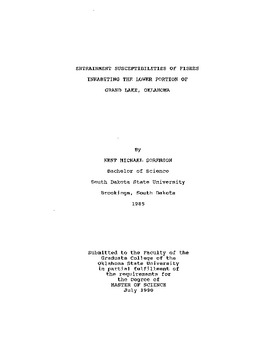| dc.contributor.author | Sorenson, Kent Michael | |
| dc.date.accessioned | 2014-12-17T20:26:45Z | |
| dc.date.available | 2014-12-17T20:26:45Z | |
| dc.date.issued | 1990-07-01 | |
| dc.identifier.uri | https://hdl.handle.net/11244/14010 | |
| dc.description.abstract | I documented the seasonal dynamics of juvenile and adult fish in the vicinity of the Pensacola Dam hydropower facility on Grand Lake, Oklahoma, to determine species-specific entrainment susceptibilities. Fishes in Grand Lake were sampled monthly from August 1988 to July 1989 using gill nets, trap nets, and electrofishing gear. Water quality profiles were recorded concurrently. I used techniques typically used to quantify foraging preferences of selective predators to estimate the entrainment susceptibilities of individual species to non-selective "predation" by hydropower intakes. Relative abundances of fishes in Grand Lake were compared to relative abundances of fishes entrained (obtained from a concurrent study estimating entrainment rates) using Strauss' electivity index to determine species-specific entrainment susceptibilities. Wilcoxon's signed-rank test was used to incorporate sampling error and test statistical significance. Fishes were not entrained at rates reflecting their relative abundance in the lake. Only 8 of the 25 species collected in Grand Lake were entrained. Entrainment of gizzard shad exceeded expectations based on their relative abundance in the reservoir and it was the only species significantly susceptible to entrainment. Susceptibility to entrainment of all other species was negative or proportional to relative abundance. High midwinter entrainment of gizzard shad resulted from their habitation of deep water proximal to the turbine intakes and cold-induced torpor. Entrainment was size-selective being skewed to enhance the selection of small fish. Occasional entrainment of white crappie and channel catfish was probably a result of the predilection of these species for structural cover in deep water as afforded by the forebay of the intake structure. Hypolimnetic anoxia associated with summer stratification precluded entrainment of all species during summer. | |
| dc.format | application/pdf | |
| dc.language | en_US | |
| dc.publisher | Oklahoma State University | |
| dc.rights | Copyright is held by the author who has granted the Oklahoma State University Library the non-exclusive right to share this material in its institutional repository. Contact Digital Library Services at lib-dls@okstate.edu or 405-744-9161 for the permission policy on the use, reproduction or distribution of this material. | |
| dc.title | Entrainment Susceptibilities of Fishes Inhabiting the Lower Portion of Grand Lake, Oklahoma� | |
| dc.type | text | |
| osu.filename | Thesis-1990-S713e.pdf | |
| osu.accesstype | Open Access | |
| dc.description.department | Wildlife and Fisheries Ecology | |
| dc.type.genre | Thesis | |
